
A savanna or savannah is a mixed woodland-grassland ecosystem characterised by the trees being sufficiently widely spaced so that the canopy does not close. The open canopy allows sufficient light to reach the ground to support an unbroken herbaceous layer consisting primarily of grasses. According to Britannica, there exists four savanna forms; savanna woodland where trees and shrubs form a light canopy, tree savanna with scattered trees and shrubs, shrub savanna with distributed shrubs, and grass savanna where trees and shrubs are mostly nonexistent.

Acacia aneura, commonly known as mulga or true mulga, is a shrub or small tree native to arid outback areas of Australia. It is the dominant tree in the habitat to which it gives its name (mulga) that occurs across much of inland Australia. Specific regions have been designated the Western Australian mulga shrublands in Western Australia and Mulga Lands in Queensland.
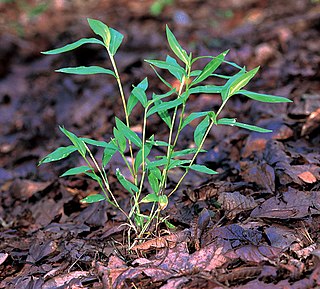
Microstegium vimineum, commonly known as Japanese stiltgrass, packing grass, or Nepalese browntop, is an annual grass that is common in a wide variety of habitats and is well adapted to low light levels. It has become an invasive species throughout parts of the world, most notably North America.
Scottsdale Reserve is a 1,328-hectare (3,280-acre) nature reserve on the Murrumbidgee River in south-central New South Wales, Australia. It is 79 kilometres (49 mi) south of Canberra, and 4 kilometres (2.5 mi) north of Bredbo. It is owned and managed by Bush Heritage Australia (BHA), which purchased it in 2006. The purchase was supportive of projects aiming to connect existing fragmented remnant habitat such as K2C. Since the 1870s up until 2006, the land was used for agriculture – primarily sheep grazing with some minor cropping. A significant component of the Reserve has been cleared of native vegetation.

Kadua coriacea is a rare species of flowering plant in the coffee family known by the common name kioʻele. It is endemic to Hawaii, where it is known only from the island of Hawaiʻi and one individual remaining on Maui. It is a federally listed endangered species of the United States.

Mediterranean forests, woodlands and scrub is a biome defined by the World Wide Fund for Nature. The biome is generally characterized by dry summers and rainy winters, although in some areas rainfall may be uniform. Summers are typically hot in low-lying inland locations but can be cool near colder seas. Winters are typically mild to cool in low-lying locations but can be cold in inland and higher locations. All these ecoregions are highly distinctive, collectively harboring 10% of the Earth's plant species.
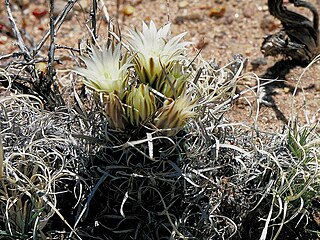
Sclerocactus papyracanthus is a species of cactus known by the common names paperspine fishhook cactus, grama grass cactus, paper-spined cactus, and toumeya. It is native to North America, where it occurs from Arizona to New Mexico to Texas and into Chihuahua, Northeastern Mexico.
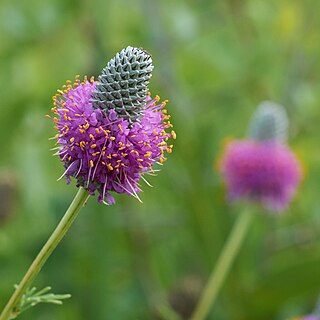
Dalea purpurea is a species of flowering plant in the legume family known as purple prairie clover. Native to central North America, purple prairie clover is a relatively common member of the Great Plains and prairie ecosystems. It blooms in the summer with dense spikes of bright purple flowers that attract many species of insects.
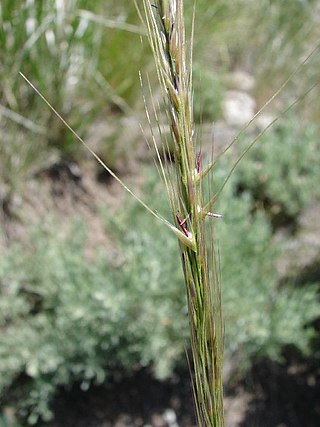
Eriocoma nelsonii is a species of grass known by the common names Columbia needlegrass, subalpine needlegrass, and western needlegrass. It is native to western North America, from Yukon and British Columbia to California to Texas.
Achnatherum richardsonii is a species of grass known by the common names Richardson's needlegrass, spreading needlegrass, and Canada mountain-ricegrass. It is native to northwestern North America, where it is distributed from Alaska and Yukon through the western Canadian provinces south to Colorado.

Calamovilfa longifolia is a species of grass known by the common names prairie sandreed and sand reedgrass. It is native to North America, where it occurs from the Northwest Territories to Ontario in Canada and as far south as New Mexico and Kansas in the United States. There are two varieties, var. longifolia being widespread in the species' range and var. magna being native to the Great Lakes region.

Calamagrostis montanensis is a species of grass known by the common names plains reedgrass and prairie reedgrass. It is native to North America, where it is found across Canada from British Columbia to Manitoba and south to Colorado in the United States.
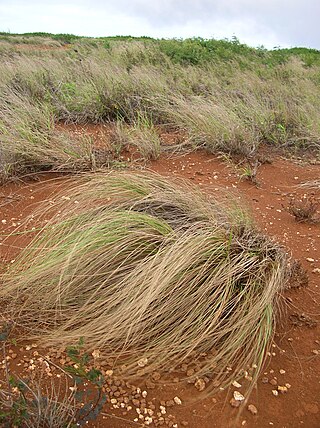
Eragrostis curvula is a species of grass known by the common name weeping lovegrass. Other common names include Boer lovegrass, curved lovegrass, Catalina lovegrass, and African lovegrass.
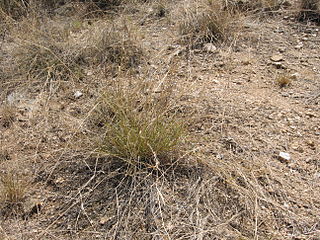
Eragrostis lehmanniana is a species of grass known by the common name Lehmann lovegrass. It is native to southern Africa. It is present elsewhere as an introduced species. It is well known as an invasive weed in some areas, such as Arizona in the United States.

Hilaria mutica, synonym Pleuraphis mutica, is a species of grass known by the common name tobosa, or tobosa grass. It is native to Northern Mexico, and the Southwestern United States, in Arizona, New Mexico, Oklahoma, and Texas.

Panicum anceps is a species of grass known by the common name beaked panicgrass. It is native to the southeastern United States, where it occurs as far north as New Jersey and as far west as Kansas and Texas.

Poa fendleriana is a species of grass known by the common name muttongrass. It is native to western North America, where its distribution extends from western Canada to northern Mexico.

Eragrostis pilosa is a species of grass in the family Poaceae. It is native to Eurasia and Africa. It may or may not be native to North America. It is widely introduced, and it is a common weed in many areas.
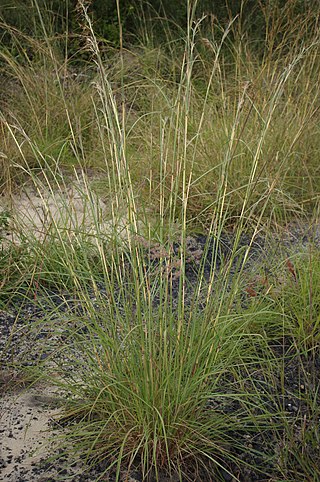
Hyparrhenia rufa is a species of grass known by the common names jaraguá, jaraguá grass, and giant thatching grass. It is native to Africa and it is widespread in the world as a cultivated forage and fodder for livestock and a naturalized and sometimes invasive species.
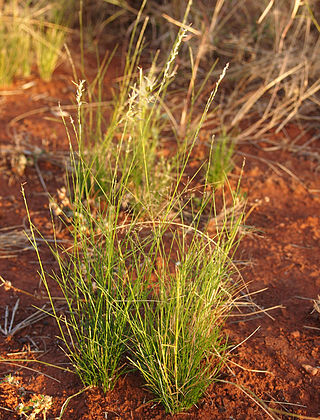
Eragrostis setifolia, commonly known as neverfail grass, is a species of perennial grass in the family Poaceae native to Australia, where it is widespread and common throughout the range lands and is commonly utilized as a pasture grass. According to IUCN classification it is listed as a least concern species throughout most of its range with the exception of Victoria where it is classified as vulnerable. It is capable of C4 photosynthesis.



















